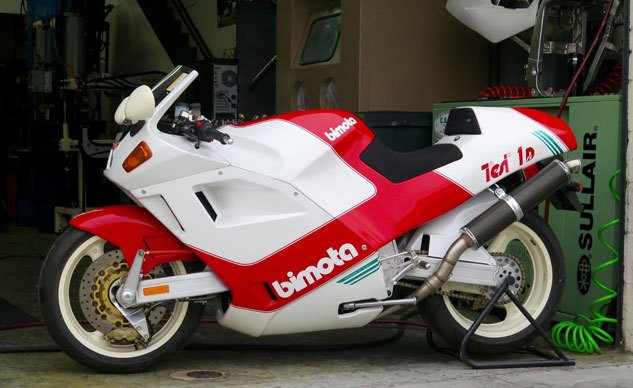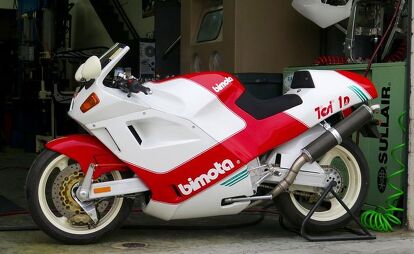Archive: Bimota Tesi 1D SR
There was a lot of hub-steer hubbub 20-some years ago
Why did the Tesi never make it big? For one thing, its $40k list price made it the most expensive motorcycle going at the time, and for another it was just too different and probably also too complex. Then again, the whole point of being a Bimota is that none of them ever make it big.
In the beginning, in 1991, the plan was to build 300 of these 851 Ducati-powered babies, with 30 slotted for North America. Wikipedia says 417 of the first-generation Tesis were produced through 1994, including 51 400cc versions for Japan (Tesi 1DJ), 50 Special Editions in ’93, 25 Final Editions in ’94 – and 144 SR models, which is what our friend Chris Redpath has here. The SR includes a refinement or two, most notably a 904cc 851 motor via 4mm longer stroke (92 x 68mm). A SoCal Bimota collector recently acquired this one (who also owns the SB8R Anthony Gobert won a World Superbike race on at Phillip Island in 2000, among others), and sent it along to MotoGPWerks for a little R&R.
Bimota had been playing with hub steering for years, at first with a hydraulic system that was plagued with problems; any master cylinder tight enough to contain its fluid introduced stiction into the steering and sometimes gave a spongy feel. Finally, taking an engineering step backwards and embracing a system of rods and levers resulted in a bike that actually worked pretty well. Bimota Chief Engineer Pierluigi Marconi claimed 25% more rigidity than a conventional fork at the time (a time before the inverted fork had been invented). The complaint then became that the Tesi lacked the final nth degree of steering feel that’s needed by actual racers, even if most street riders of the Tesi would never feel the difference.
What a lot of street riders did feel, though, was a disconcerting lack of brake dive, and that was all part of the Tesi master plan: The plan was to eliminate the binding and stiction that telescopic forks are prone to under hard braking, forces that were thought to compromise cornering ability and feel.
As it turns out, what we seem to have learned over the years, especially now that stronger inverted forks are the norm, is that a little fork flex is not a bad thing, and might be part of what produces that “feel” we’re accustomed to when braking and/or leaned over. Like frames with “tuned flex,” fork tubes that bend a little act as suspension when the bike is at full lean.
In any case, the Tesi is still a beautiful piece of work and a reminder of how quickly time marches on. Its milled frame members were engineering marvels at the time, but Redpath’s mill in his small shop now turns out better-finished pieces of alloy. And the Tesi’s instrument panel, with futuristic bar-graph tachometer, now looks a little like a dated sci-fi movie prop.
All was not lost, by any means, even if the Tesi didn’t kill off the telescopic fork as some wishful-thinking Bimotans predicted. When Bimota finally bounced back after the VDue debacle, it started right back in with the Tesi 2D, in 2005, followed by the 3D in 2007 – which its website says it will still be happy to build for you. The new front swingarm/steering system now lives entirely on the left side of the bike and no longer passes through the frame; now it uses fewer links and is therefore more precise than before. And not only is the 3D more a sit-up straight naked bike, it even uses Ducati’s beautiful old air-cooled 1078 Dual Spark engine. Another complaint with the 1D was its ginormous turning radius (which we rediscovered when pushing the bike around); the 3D solves that problem as well. MO’s review from 2009 is here.
Also, the man who’s credited with really putting Pierluigi Marconi’s “thesis” to work at Bimota, Ascanio Rodorigo, carries on the hub-steer cause with his Vyrus machines.
Redpath is a busy man and had not got around to throwing in a new battery yet, since all the bodywork needs to come off to access it. Hence we could not switch the power on to see what the odometer has to say. But when we took off the lowers to get a look at the suspension particulars (a simple matter of about ten Dzus fasteners), the titanium header pipes showed zero discoloration, like the thing had never even been started.
It’s hard to believe Bimota would ship a Tesi without somebody taking it for a test spin around Rimini, but that’s what it looks like. It’s even harder to imagine the person who bought this thing having the patience and/or high-living negligent lifestyle that would allow it to sit for 33 years without being ridden. Its Michelin Hi-Sports also look new and nubby original; this old bike’s patina consists of nothing more than a light coating of dust.
Anyway, this exotic old thing reminds me of a time, in the early ’90s, when I’d often pinch myself, having arrived at a pretty exotic place, Cycle magazine. Steve Anderson dispatched Kevin Cameron to San Francisco to get the scoop on the first one in the U.S., owned by an anonymous person somebody later told me was the brother of famed dragracer Kenny Bernstein, the Budweiser King! – which would make the first Tesi even cooler if true.
Meanwhile, I was back writing about the new Suzuki Bandit 400 Rev Rabbit! and trying to ’splain why “rabbit” works on the cover … Speaking of the Tesi, though, Kevin C. invoked GP historian Lawrence Pomeroy for possibly the first time in explaining why the radical new Bimota would have an uphill battle ahead of it: “The first instance of superior principle is invariably defeated by the developed example of established practice.”
If at first you don’t succeed … Does anyone out there have a 3D we can borrow? Maybe a Vyrus? Anyone??
More by John Burns















































Comments
Join the conversation
Cool idea, they should try it out on a cruiser/dragster-type build. Or even a dirt/enduro bike, can you imagine this at Supercross or flat-track?
It is so ironic, that decades passed by, but the simple conventional fork design proved to be the best. And even BMW's recent attempts with all their limitless resources couldn't change that. And everything that was needed is bolting them upside down.